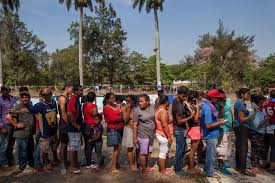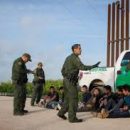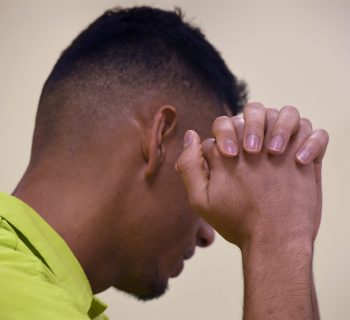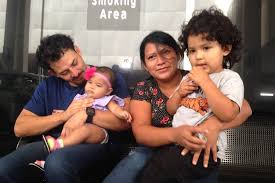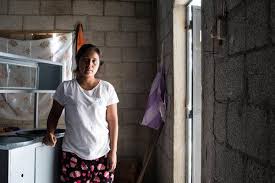By Kirk Semple ~ New York Times ~ April 7, 2018
MATÍAS ROMERO, Mexico — With a sarcastic half-smile, Nikolle Contreras, 27, surveyed her fellow members of the Central American caravan, which President Trump has called dangerous and has used as a justification to send troops to the border.
More than 1,000 people, mostly women and children, waited patiently on Wednesday in the shade of trees and makeshift shelters in a rundown sports complex in this Mexican town, about 600 miles south of the border. They were tired, having slept and eaten poorly for more than a week. All were facing an uncertain future.
“Imagine that!” said Ms. Contreras, a Honduran factory worker hoping to apply for asylum in the United States. “So many problems he has to solve and he gets involved with this caravan!”
The migrants, most of them Hondurans, left the southern Mexican border city of Tapachula on March 25 and for days traveled north en masse — by foot, hitchhiking and on the tops of trains — as they fled violence and poverty in their homelands and sought a better life elsewhere.
This sort of collective migration has become something of an annual event around Easter week, and a way for advocates to draw more attention to the plight of migrants.
But this particular caravan caught the attention of Mr. Trump, apparently after he heard about it on Fox News. In a Twitter tirade that began Sunday, he conjured up hordes of dangerous migrants surging toward the border. He demanded that Mexican officials halt the group, suggesting that otherwise he would make them pay dearly in trade negotiations or aid cuts.
Mr. Trump even boasted that his threat had forced Mexico’s government to halt and disperse the caravan participants. But there was no evidence of that on Wednesday.

The caravan migrants speaking with Mexican immigration officials. CreditBrett Gundlock for The New York Times
Mexican migration authorities were distributing transit permits that would either give the migrants 20 days to leave the country or 30 days to formally apply for legal immigration status in Mexico.
Irineo Mujica, Mexico director of Pueblo Sin Fronteras, an advocacy group that is coordinating the caravan, called Mr. Trump’s Twitter attacks and promise of a militarized border “campaign craziness.”
“There are 300 kids and 400 women,” he said. “Babies with bibs and milk bottles, not armaments. How much of a threat can they be?”
After making steady progress for a week through southern Mexico, the group has been camped at the sun-blasted sports complex here since Saturday, before Mr. Trump started tweeting about it, surviving on food and water donated by residents in this rural town. They have slept on the ground, or in the bleachers of a soccer stadium, or under the roofs of a few derelict structures on the property.
A stream, shrouded by bushes and trees, is the latrine for the group, which once numbered about 1,500 but now hovers around 1,100, organizers said.
The caravan population has declined as participants have received travel papers and departed, though many of the hundreds who remain hope to continue moving north in a large group, which they do for safety from criminals.
Organizers said they were seeking buses or other transportation to move the migrants to the city of Puebla, about 250 miles away, to attend planned know-your-rights workshops on immigration law in Mexico and the United States.

Migrants rested Wednesday at a temporary camp in the Mexican town of Matías Romero. CreditBrett Gundlock for The New York Times
The group, organizers and advocates said, represented a regional humanitarian problem, not a security crisis for the United States, as Mr. Trump has suggested.
“What he’s attacking is a supremely vulnerable population,” said Gina Garibo, projects coordinator in Mexico for Pueblo Sin Fronteras.
In response to Mr. Trump’s tweets and his plans to militarize the border, the Mexican Senate unanimously passed a nonbinding statement on Wednesday urging President Enrique Peña Nieto to suspend cooperation with the United States on immigration and security matters — “as long as President Donald Trump does not conduct himself with the civility and respect that the Mexican people deserve.”
Caravan organizers also said their intent was never to storm the border, especially not with a caravan of this size. While the original plan included the possibility of escorting the caravan to the northern border of Mexico, organizers had expected the group to mostly dissolve by the time it had reached Mexico City.
But now the leaders expect to end the caravan at the capital, owing to the unwieldy size of the group, leaving migrants to decide for themselves what action to take from there.
Most caravan members interviewed here on Wednesday said their dream was to reach the United States, though some said that if they were unable to enter legally, they might seek legal status in Mexico.
Bayron Cardona Castillo, 27, said he had been traveling with his 2-year-old daughter, Glirian Dayani, from their home in Honduras and was hoping to apply for asylum in the United States. But he did not seem clear on the requirements.

The camp offered the migrants a chance to wash and rest. Most had eaten little in more than a week. CreditBrett Gundlock for The New York Times
“The truth is, what we’re looking for is a way to live in peace, in tranquillity, with employment,” he said. “In my case, all I ask is an opportunity, a chance to work and help my family.”
Organizers said that once the migrants consult with volunteer lawyers in Puebla, many will conclude their cases are not strong enough to apply for legal protections in the United States and will choose to remain in Mexico.
Even without a wall and the United States military, getting into the United States is tough, Mr. Mujica said.
“You’re like the waves crashing into the border and bouncing back,” he said. “And you end up working in Mexico.”
Mexico has increasingly become a destination for migrants from Central America. Last year, about 14,600 applied for asylum, 66 percent more than in 2016 and 11 times as many as five years ago. Many applicants in recent years have been from Honduras.
Some of the increase reflects stronger enforcement on Mexico’s southern border because of a United States-backed plan to curb illegal northbound migration. Once stopped by the Mexican authorities, many detainees have come to learn they may be eligible for sanctuary in Mexico.
On Tuesday, Mr. Trump suggested that pressure he had applied on the Mexican government had stopped the caravan in Matías Romero. But organizers from Pueblo Sin Fronteras said that the caravan’s momentum had simply slowed, because of its size and many vulnerable participants, especially young children and infants.

Resting in the migrant camp on Wednesday. CreditBrett Gundlock for The New York Times
Mr. Peña Nieto’s administration also appeared to push back at Mr. Trump’s contention that he had coerced them.
In a joint statement, the ministries of interior and foreign relations said the caravan was halted by the participants, and not because of “any external or internal pressure.”
Guillermo Baltazar Rivas, 20, from El Salvador, and his two sisters, were among the scores of migrants who were given travel permits on Wednesday. They slipped the documents into their passports for safekeeping.
They said they did not know exactly what they would do next — head out on their own or remain with the group. Eventually, though, they hoped to apply for asylum in the United States, where close relatives lived, on the grounds that gangs murdered their brother and threatened the rest of the family with death.
With little access to news or social media among the caravan members, word of Mr. Trump’s fixation on their northward journey spread via word-of-mouth.
“He says we are criminals, that we are assassins, that he isn’t going to let us enter, that he’s going to send the military,” Mr. Rivas said. “It’s very — how do I say it? — it’s very selfish that he doesn’t let us pass.”
Ms. Contreras said she knew many caravan participants who had plans to make new lives in Mexico City, Puebla and Tijuana. But she, too, had designs on making it to the United States, as did two travel-mates. Asylum was her goal: She had been threatened with death by a drug trafficker after she had spurned his romantic advances and his efforts to recruit her into his criminal business.
The common denominator among caravan participants, Ms. Contreras said, was their agonizing decision to migrate.
“Who wants to leave their country, the comfort of their home, their families?” she asked. “It’s a very difficult thing.”
Source: Kirk Semple ~ New York Times

